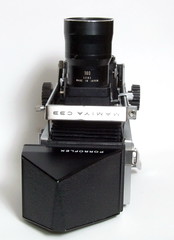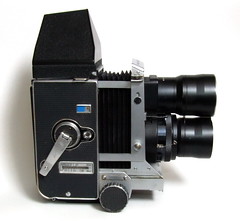Difference between revisions of "Mamiya C"
m (correcting Collection Appareils link) |
m (correcting Collection Appareils link) |
||
| Line 135: | Line 135: | ||
* [http://www.thebokeh.com/-article/15/4/ C series] featured in the [http://www.thebokeh.com/-article/15/0/ TLR on a budget guide] at [http://www.thebokeh.com/-home/ TheBokeh.com] | * [http://www.thebokeh.com/-article/15/4/ C series] featured in the [http://www.thebokeh.com/-article/15/0/ TLR on a budget guide] at [http://www.thebokeh.com/-home/ TheBokeh.com] | ||
* [http://www.btinternet.com/~g.a.patterson/mfaq/m_faq-mamiya.html Mamiya TLR system summary] (follow the arrow links on top of the page), [http://www.btinternet.com/~g.a.patterson/c220/c220.html Mamiya C220], [http://www.btinternet.com/~g.a.patterson/c330/c330.html Mamiya C330] and [https://webfiles.berkeley.edu/~grahamp/mamiyamisc/index.html other features] at [http://www.btinternet.com/~g.a.patterson/ Graham Patterson's page] | * [http://www.btinternet.com/~g.a.patterson/mfaq/m_faq-mamiya.html Mamiya TLR system summary] (follow the arrow links on top of the page), [http://www.btinternet.com/~g.a.patterson/c220/c220.html Mamiya C220], [http://www.btinternet.com/~g.a.patterson/c330/c330.html Mamiya C330] and [https://webfiles.berkeley.edu/~grahamp/mamiyamisc/index.html other features] at [http://www.btinternet.com/~g.a.patterson/ Graham Patterson's page] | ||
| − | * [http://www.collection-appareils.fr/x/html/page_standard.php?id_appareil=11287 C3], [http://www.collection-appareils.fr/ | + | * [http://www.collection-appareils.fr/x/html/page_standard.php?id_appareil=11287 C3], [http://www.collection-appareils.fr/x/html/page_standard.php?id_appareil=11288 C33], [http://www.collection-appareils.fr/x/html/page_standard.php?id_appareil=11290 C220],[http://www.collection-appareils.fr/mamiya/html/mamiya_C330.php C330], on [http://www.collection-appareils.fr/general/html/francais.php www.collection-appareils.fr] by Sylvain Halgand |
===Photographers Using the Mamiya C330=== | ===Photographers Using the Mamiya C330=== | ||
Revision as of 01:14, 17 March 2012
The Mamiya C series is a professional-level series of twin lens reflex medium format cameras made in Japan. One notable distinction of the C series is the fact that they can use interchangeable lenses—a feature only found on one other TLR camera, the Koni Omegaflex.
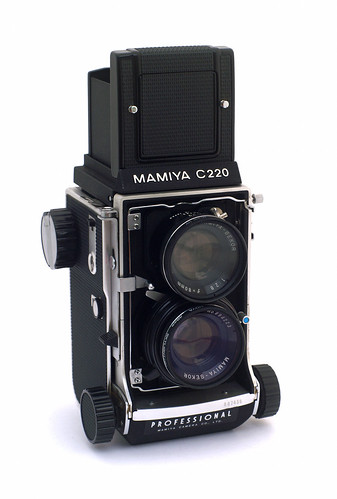
|
| image by Steve Harwood (Image rights) |
Contents
C-Series Body Versions
| ||
|
- Mamiyaflex C (1956-58)
- Mamiyaflex C2 (1958-62)
- Mamiya C3 (1962-65)
- Mamiya C33 (1965-69)
- Mamiya C33 Professional
- Mamiya C22 (1966-68)
- Mamiya C220 (1968-?)
- Mamiya C330 (1969-74)
- Mamiya C330f (1972-82)
- Mamiya C220f (1982-95)
- Mamiya C330s (1983-94)
Available lenses
- 55mm f4.5
- 65mm f3.5 chrome shutter
- 65mm f3.5 blue dot
- 80mm f2.8 chrome shutter
- 80mm f3.5
- 80mm f2.8 blue dot
- 80mm f2.8 S
- 105mm f3.5 chrome shutter
- 105mm f3.5 D
- 105mm f3.5 DS
- 135mm f4.5 chrome shutter
- 135mm f4.5 black shutter
- 180mm f4.5 chrome
- 180mm f4.5 black shutter
- 180mm f4.5 SUPER
- 250mm f4.5 black shutter
The Mamiya C3
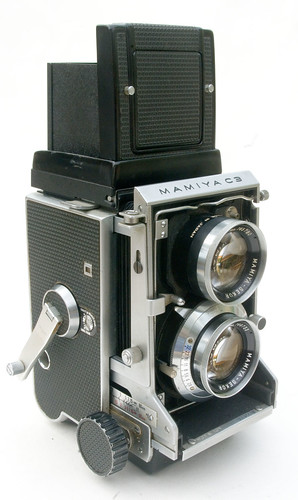
|
| Mamiya C3 image by Dave Dockerill (Image rights) |
Mamiya began to produce 6x6 twin lens reflex cameras in the 1950s the first, now very rare, was a conventional design, this was quickly followed by the C series, which broke away from the traditional TLR designs used by many different manufacturers. The C3 was the third development of the C preceded by the C and C2. The C3 was the version that became popular with amateur and professional photographers and was the foundation for the success of the following models.
There were three very significant elements to the design :
- It was possible to use interchangeable lenses.
- A double extension bellows system of focusing permitted very close focus.
- The film path spool to spool was absolutely straight
Mamiya extended the cameras versatility even further with a range of accessories including various focusing attachments and a sheet film back. The resulting design was more cumbersome than the usual TLR but was considerably more versatile, and quickly found favour with serious amateurs and professionals.
Changing Lenses On the Mamiyaflex

|
| Mamiya C3 180mm Sekor lens image by Dave Dockerill (Image rights) |

|
| C3 Lens Change image by Dave Dockerill (Image rights) |
Each set of interchangeable lenses had its own shutter and iris diaphragm, this was not an entirely new concept but it was the first time it had been used on a TLR camera. The shutters used were Seiosha leaf shutters with slow speeds and X and M sync. Mamiya devised a system to allow the lens unit to be changed on a loaded camera.
- Turn the knob on the side of the camera to “ unlock” this would raise a flap behind the shutter to prevent light reaching the film plane, put a red marker in the viewfinder to indicate the light path was now obstructed, and release a lock on the lens retainer. Hence it was not possible to remove a lens unless the shutter aperture was blanked off.
- The clip retaining the lens could now be released and the lens removed
The system gave the professional photographer a couple of significant advantages over the conventional TLR . The same camera could now be used for wedding groups with a wide lens and for formal studio portraits with a long focus optic. A further consideration was, that the most vulnerable component in any camera is the shutter, if a shutter went down on the Mamiya the lens could simply be changed.
Close Focus With The Mamiya
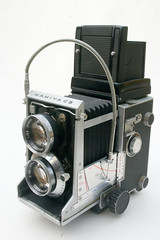
|
| Mamiya Bellows At Full Extension image by Dave Dockerill (Image rights) |
The double extension bellows to permit close focus is a system that dates back to the days of brass and timber cameras. The Mamiya C series was the only time it had been employed on a TLR and it did mean Mamiya also had to fit the C series with a conventional bellows. One problem with the extended bellows set up is that at full extension there is considerable light loss within the bellows and without TTL exposure control the photographer has to adjust the exposure in relation to the amount of extension that is used. Mamiya attached a chart to the side of the C3 to provide guidance on this adjustment
The second problem with close focus on the Mamiya was the question of parallax error brought about by the vertical separation of the viewing and picture taking lenses. This error could be quite severe at close distances. Mamiya provided a solution with a device called a Paramender, it fitted between the camera and the tripod. The photographer focused and composed the picture on the screen as usual, then activated the Paramender. Which simply moved the camera upwards by an amount equal to the distance between the viewing and taking lenses, so that the taking lens now was in the position that was occupied by the viewing lens.
General links
- C series featured in the TLR on a budget guide at TheBokeh.com
- Mamiya TLR system summary (follow the arrow links on top of the page), Mamiya C220, Mamiya C330 and other features at Graham Patterson's page
- C3, C33, C220,C330, on www.collection-appareils.fr by Sylvain Halgand
Photographers Using the Mamiya C330
Manuals and documentation
- Manual of the Mamiya C3 available on the Favorite Classics section of [.kyphoto.com
- Mamiya C330 Camera Manual : Photo-Manuals.com by Ben Squire

